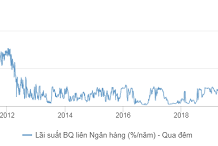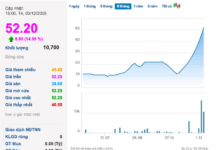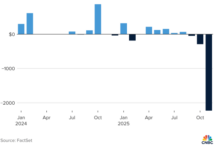On September 7th afternoon, at the regular Government press conference for August, SBV Deputy Governor Dao Minh Tu informed that credit outstanding growth reached 7.15% while the target for this year is 15%.
Credit growth will expand investment, thereby contributing to economic growth. Therefore, the SBV is implementing many solutions, focusing on lowering lending rates. The lending rate for new loans currently averages 6.23%, down 0.86% compared to the end of 2023; while the deposit rate is 3.84%, up 0.23%, a very small increase.
According to the Deputy Governor, although the deposit rate has increased, the lending rate has decreased, indicating that commercial banks have shared profits with businesses. This means paying higher interest rates to depositors while lending at lower rates, narrowing the spread and likely reducing commercial banks’ profits compared to previous years.
Since the beginning of April, there have been mixed trends in adjusting deposit rates among commercial banks. From September 5th, DongABank increased deposit rates for all terms by 0.5-1.3 percentage points. Specifically, the interest rate for 1-month term deposits increased to 3.8%/year, 3-month term to 4%/year, 6-month term to 5.2%/year, 12-month term to 5.8%/year, and over 12-month term to 6%/year.
Similarly, VPBank raised rates for all terms by 0.2-0.5 percentage points from August 8, 2024. For deposits below VND 1 billion, the bank offers an interest rate of 3.5%/year for 1-month term, 4.9%/year for 6-month term, 5.4%/year for 12-month term, and 5.7%/year for over 12-month term.
VIB made a slight increase of 0.1-0.2 percentage points for deposit terms below 12 months. Specifically, for deposits below VND 300 million, VIB offers an interest rate of 3.2%/year for 1-month term, 3.5%/year for 3-month term, and 4.5%/year for 6-9-month term.
Conversely, BAB reduced rates for all terms by 0.1-0.2 percentage points from August 14, 2024. The interest rate for 1-month term deposits decreased to 3.5%/year, 3.8%/year for 3-month term, 5%/year for 6-month term, and 5.6%/year for 12-month term.
PvcomBank decreased the interest rate for 1-month term deposits by 0.05 percentage points to 3%/year, while increasing the rate for 3-month term deposits by 0.05 percentage points to 3.3%/year, with the remaining terms unchanged as of August 21, 2024.
As of September 9, 2024, personal savings deposit rates for 1-3 month terms ranged from 1.6-4%/year, 6-9 month terms from 2.9-5.5%/year, and 12-month terms from 3.7-5.8%/year.
For the 12-month term, SGB and DongABank offered the highest deposit rate at 5.8%/year, followed by BVB at 5.7%/year, and both VIB and BAB at 5.6%/year.
For the 6-month term, NVB maintained the highest interest rate at 5.25%/year, followed by DongABank at 5.2%/year.
Meanwhile, for the 3-month term, NVB offered the highest rate at 4%/year.
|
Personal savings deposit rates at banks as of September 9, 2024
|
At foreign banks, Public Bank continued to slightly increase interest rates for terms of up to 3 months. As of September 9, 2024, for the 12-month term, Public Bank offered the highest rate at 5.5%/year. For the 6-month term, Public Bank maintained the highest interest rate at 4.7%/year.
|
Personal savings deposit rates at foreign banks as of September 9, 2024
|
Solving the Input-Output Interest Rate Differential Equation
Assoc. Prof. Dr. Dinh Trong Thinh, Economic Expert, assessed that there is currently significant pressure to increase interest rates. If deposit rates are too low, it will not attract depositors, so banks have recently increased their input rates.
However, the Government and SBV’s direction is to continue lowering lending rates to support businesses, so commercial banks try to keep lending rates low. From now until the end of the year, input rates will remain stable or increase slightly, while output rates will not increase.
Assoc. Prof. Dr. Nguyen Huu Huan, Lecturer at the University of Economics Ho Chi Minh City, commented that the SBV has directed lowering lending rates but needs to provide support as commercial banks must ensure NIM. If input rates increase but output rates remain unchanged, it will definitely affect banks’ business results. This will undoubtedly “cause difficulties” for banks.
Therefore, Mr. Huan suggested that if the SBV wants to continue its loose monetary policy, it will need to inject more money, especially in the interbank market, which will help solve liquidity for commercial banks. This will prevent banks from raising deposit rates in the future.
Mr. Nguyen Quang Huy, CEO of Finance and Banking, Nguyen Trai University, stated that commercial banks’ capital mobilization needs remain high, especially as credit demand from businesses and consumers is rising after the challenging pandemic period. To meet this demand, many banks have had to increase deposit rates to attract more capital from individuals and enterprises.
Competitiveness among banks is also a factor driving the increase in deposit rates. When some banks raise rates to attract customers, others must follow suit to maintain their market share. This creates a spiral of increasing deposit rates, putting more pressure on the system’s funding costs.
In this context, the SBV’s request to lower lending rates may not be easily implemented across the board, as many commercial banks are still facing liquidity and capital mobilization challenges. However, it will depend on the management strategy of each commercial bank, which will determine the degree and pace of lending rate reduction. Banks may choose to lower rates for certain customer segments or promotional loan products while maintaining reasonable rates for higher-risk customer groups to protect profit margins.





































